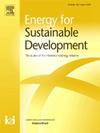伊朗实施净零碳城市的障碍分析
IF 4.9
2区 工程技术
Q2 ENERGY & FUELS
引用次数: 0
摘要
尽管实现这一目标很重要,但伊朗等发展中国家在向“净零碳城市”(NZCCs)过渡的努力中面临着障碍。检查这些障碍是至关重要的。本研究旨在识别和分析在伊朗实现nzcc的障碍。在仔细审查文献后,进行了专家调查,以确定障碍及其相互联系。文献回顾和访谈为障碍列表的选择提供了信息。其次,基于解释结构模型和MICMAC分析,进行了一项调查,以确定障碍之间的联系。结果表明,“缺乏全面的政策”是伊朗实现nzcc的最大障碍。分层模式的其他重要障碍是“公众意识不足”、“能源技术投资不足”、“土地利用方式不当”、“化石燃料价格低”和“有效运输基础设施有限”。基于MICMAC分析,该研究还确定了障碍之间的驱动或依赖功率水平集群。这项研究的结果可以帮助城市规划者和决策者制定战略,减少实现nzcc愿景的障碍,并促进伊朗的气候适应型城市地区。本文章由计算机程序翻译,如有差异,请以英文原文为准。
Analysis of barriers to the implementation of net-zero carbon cities in Iran
Developing countries, such as Iran, face barriers in their efforts to transition towards “net-zero carbon cities” (NZCCs), despite the importance of achieving this goal. It is crucial to examine these barriers. This study aims to identify and analyze the barriers to achieving NZCCs in Iran. After carefully reviewing the literature, an expert survey was conducted to identify barriers and their interlinkages. The literature review and interviews informed the selection of a list of barriers. Next, a survey was conducted to identify linkages between the barriers based on Interpretive Structural Modeling and MICMAC analysis. The results reveal that the “Lack of comprehensive policies” is the most important barrier to realizing NZCCs in Iran. Other important barriers in the hierarchical model are “Lack of public awareness”, “Lack of investment in energy technologies”, “Inappropriate land use pattern”, “Low price of fossil fuels”, and “ Limited active transport infrastructure”. Based on the MICMAC analysis, the study also identifies clusters of driving or dependence power levels among the barriers. The findings of this research can help urban planners and policymakers build strategies to reduce barriers to achieving the vision of NZCCs and promote climate-resilient urban areas in Iran.
求助全文
通过发布文献求助,成功后即可免费获取论文全文。
去求助
来源期刊

Energy for Sustainable Development
ENERGY & FUELS-ENERGY & FUELS
CiteScore
8.10
自引率
9.10%
发文量
187
审稿时长
6-12 weeks
期刊介绍:
Published on behalf of the International Energy Initiative, Energy for Sustainable Development is the journal for decision makers, managers, consultants, policy makers, planners and researchers in both government and non-government organizations. It publishes original research and reviews about energy in developing countries, sustainable development, energy resources, technologies, policies and interactions.
 求助内容:
求助内容: 应助结果提醒方式:
应助结果提醒方式:


